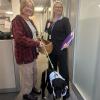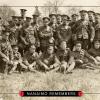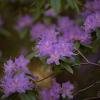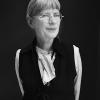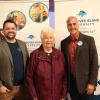
March 3, 2011 - 10:00pm
By Susan Lymbery
A few weeks ago, I received a package in the post bearing no return address, but simply “Michael Warren” and an Irish stamp of a common red squirrel. Inside, I found a Hillsboro Fine Art catalogue of Warren’s forty-year retrospective, Kireji. In traditional haiku poetry, a kireji supports the verse structure and acts as a caesura, a pause or a cutting word. Michael Warren penned a self-portrait in a mirrored image continuous-line on that title page. As an unexpected bonus, his sketch rises from the page like a whiff of Wexford green. Michael’s sculptures rise too, raw and pure in the context of landscape, to make us pause and ponder his gift.
This past June, there was so much in Ireland to see, so much that Vancouver Island University’s Dr. Timothy Brownlow put into context for us. Tim has spent forty-five years researching, writing, and teaching Irish literature, most recently for VIU’s Faculty of English. Also an Honorary Research Associate, Tim collaborated with VIU’s Centre for Continuing Studies and with Libby McGrattan, a Liberal Studies Faculty Secretary, together spending ten months designing an itinerary of Ireland’s best.
Our tour began as we gathered in Parliament Square, Trinity College Dublin (TCD), founded as the College of the Holy and Undivided Trinity by Queen Elizabeth I in 1592.
As a Malaspina U-C undergraduate in Tim’s classes, I’d imagined TCD well and was fully prepared to see Swift or Goldsmith at a Rubrics window, Wilde pacing the New Square narrows, Berkeley and Burke huddled in the stacks, and Beckett—pawn in hand, a shadowy figure by the back gate in the midst of an endgame. In the classroom, Brownlow interwove history, music, food, crafts with Irish literature. But to be in Dublin, standing there on the hallowed cobbles by the Campanile, was more than I’d imagined.
A master at contextualizing the ancient and modern, Tim began with a classroom lecture. Then we walked to the Old Library which houses The Book of Kells, the four Gospels and New Testament in ninth-century images and Latin calligraphy. The Vikings, it’s said, once stole the jewelled cover, but not realizing the prize, left the manuscript intact. The illuminations of The Book of Kells are mythic and marvellous, with extravagant patterning and lettering in iron gall ink on calf skin vellum. Some of the inks, it’s said, were derived from marine shells, crushed pearls and beetles’ wings. Kells’ Celtic knots, like those in the Book of Durrow, represent a continuous line, akin to Montaigne’s celestial wheelings, windings and interlacements, and as such they’re deeply hypnotic. I recalled the slides Tim showed of the Long Room. I also recalled the yearning I felt as an undergrad to be there. And here I was, not so many years later, with Dr. Brownlow himself, who was also in passionate pursuit of his own past.
From the Long Room, our tour group headed to the Provost’s House Stables, converted now for Graduates in harness—a site off limits to tourists, but unlocked for a TCD alumnus, so we could study Warren’s bronze, Go Deo: homage to Samuel Beckett. Here, I seized the reins, telling our group about the ways Go Deo symbolizes En Attendant Godot’s stage directions, forming an uppercase “T,” effectively deconstructing the Christian cross and shattering the concept of a triune godhead. The upturned tree roots confirm Beckett’s question: Do we wait forever? Does anything await us? Go Deo, in Gaelic, means forever. In his bronze Go Deo, Warren captures all that is mysterious and darkly magical.
We saw the National Gallery, with its Yeats Room, and then moved on to magnificent Merrion Square and Oscar Wilde’s house—now the American College Dublin. Leinster House, once home to the aristocratic rebel Lord Edward Fitzgerald, also faces Merrion Square; now, the National Parliament’s Dáil (House of Representatives) and the Seanad (the Senate) meet there. That night, we dined at Gallagher’s Boxty House in Temple Bar and then enjoyed live traditional music and copious quantities of Vitamin G at Oliver St. John Gogarty’s pub. All this on Day One.
Day Two began with a tour of the Guinness Brewery. Although the Guinness recipe’s kept secret, the story’s told from early coopering to iron lungs to global distribution. And though it wasn’t mid-morning, we learned how to pour a perfect one-hundred-and-twenty-second pint. Then, we left the Guinness Brewery for Dublinia. The Vikings settled in Dubh Linn, or black pool, in 841. In a recreated Viking marketplace, we donned coarse woollen cloaks, tried the stocks and slave’s shackles, and wrote in runic lettering. Over time, Dublin’s Viking gods gave way to monotheism. The city’s Cathedral of the Holy Trinity, known as Christ Church, was founded by the Hiberno-Norse King Sitric Silkenbeard in 1030, while the other ancient cathedral, St. Patrick’s, dates from 1191; both are Church of Ireland. In 1649, Cromwell took his possession of St. Pat’s to biblical proportions by stabling his Flanders mares in the nave. During Lent in 1742, both cathedral choirs combined for a first of another kind, as seven hundred souls—the men swordless, the women hoopless to accommodate the crowds—gathered on Fishamble Street at Neal’s Musick Hall to hear the first performance of Handel’s Messiah. By the afternoon of Day Two, we’d drawn Guinness gold and Viking runic, pondered Cromwell’s abomination of desolation and touched the chair Handel used to deliver Christendom’s most famous oratorio. By day’s end, we felt rather breathless.
Day Three saw us in County Kildare, where the Liffey meets the Rye at Leixlip. Here, in 1755, Arthur Guinness brewed his first ale; that same year, Samuel Johnson published his Dictionary of the English Language. The jury’s still out on which matters most. Two centuries later, the Honourable Desmond Guinness and his late wife Mariga founded the Georgian Society to protect, promote and refurbish the country’s glorious Georgian architecture. The exquisite restoration of Castletown House, once home to Speaker William Conolly, is due to the efforts of the Georgian Society. Desmond Guinness welcomed us with refreshments, a magnificent presentation on the Georgian Society, and a tour of his home.
Leixlip Castle is also home to two artful baby houses; the larger doll house in the Red Room seems worthy of the V&A. Inside, there were Lilliputian barrels with minutely branded glasses, porcelain baths, hand-stitched Persian rugs, silks on the walls, a galvanized bucket, a tiny hammer and nails, wee iron stoves, petit-point tapestries, and a Dinky die-cast parked in the kitchen. In the eighteenth and nineteenth centuries, guests brought hostess gifts for the baby house; I can’t help but wonder what other treasures the massive drawers hold.
Other castles and treasures followed: the James Joyce Cultural Centre, the Joyce tower at Sandycove where Stephen Dedalus and “Stately plump Buck Mulligan” (as well as Tim Brownlow) spoke the opening words of Ulysses. We saw Powerscourt, the Wicklow Mountains, and mystical Glendalough, founded by St. Kevin in the sixth century, with its well-preserved round tower. We imagined Ireland’s great nationalist, Charles Stewart Parnell, pacing his balcony at Avondale, rehearsing his now-famous speeches for Home Rule. We saw Woodenbridge and Thomas Moore country, and the Avoca Handweavers, near Tim’s childhood home. Then, we drove a meandering line through the lush rolling greens of Wexford to the home of world-renowned sculptor Michael Warren.
With his wife Maria, Michael hosted a luncheon in Tim Brownlow’s honour. Michael regaled us with a discussion on Simone Weil, ratio and space, physics, mass and movement. We toured his studio, the garden and the grounds. For Michael, sculpture is all about limits; he lifted a cabriole-legged chair to the top of the dining room table. A woman’s shoe, I noted, accomplishes the same trick, by lifting mass and displacing it within a tiny high heel, creating another continuous line of unbroken beauty.
The Irish Crafts and Design Centre and beautiful Kilkenny Castle furthered our contextualization of Ireland. Later that day, Tim’s cousin—Academy Award-winning film historian Kevin Brownlow—invited us to his summer home by the sea in County Waterford. This setting was a superb backdrop for Kevin’s lecture on silent film, westerns, cinematic history and even America’s sweetheart, Canadian Mary Pickford. As an Oscar-winning director and producer, Kevin has earned worldwide fame for his preservation work of the silent film era, including a restoration of a once-lost Chaplin film. Like his scholarly first cousin, Kevin’s mastery of film history is encyclopaedic, making for an intimate, utterly charming lecture.
Our tour master led us on to Cork where we visited the Cobh Heritage Centre and the Queenstown Story. There, we learned about American Wakes and coffin ships, Annie Moore and Ellis Island. We learned, too, of Grosse-Île, Quebec, where some 6,000 Irish émigrés died in sight of the promised land. An early film shows a sailing vessel plying high winds and heavy seas. Recreated scenes of conditions below deck made us realize the profound sense of exile émigrés must have felt, forced to flee their homeland in hopes of prosperity. Between 1820 and 1880, three-and-a-half million Irish mingled their tears in Cork Harbour before leaving Ireland. From the sad farewells of Queenstown, we ventured on to Blarney Castle, former home to the great Irish chieftain, Cormac MacCarthy. Although never known to have been at a loss for words—either witty or wise, Tim climbed that tower, bent backwards and kissed the famed Stone of Eloquence; Bronwen Smith and I wandered the enchanted Rock Close instead, the Druid’s Circle, the Sacrificial Altar and the Witch’s kitchen. Then we climbed—eyes shut tight backwards up the Wishing Steps. After a scenic drive to Killarney, our group hopped aboard jaunting car[riage]s to the Herbert family’s Muckross House. At Muckross, we toured the house and admired Irish pottery, weaving, and bookbinding.
We wove our way into County Clare to Bunratty Castle—a grand fifteen-century castle restored by Lord Gort. Once the stronghold of the O’Briens, Princes of Thomond, this medieval fortress with period furnishings and richly costumed actors, recreates a sense of Celtic glory. We gathered at Durty Nelly’s, established in 1620, for a pint of plain with Libby and Tim. Durty Nelly, once the toll-keeper of a bridge near the Shannon, sold a poteen so powerful, it was said to heal pain, mend broken hearts and even—on occasion, restore life. After exploring Durty Nelly’s liquid treasures, we headed over to the castle for the Ceili or gathering, for the traditional bread-and-salt welcome, warm mead, and harp and violin. We toured Bunratty Folk Park’s nineteenth-century homes warmed by peat, as well as the shops and mills, pigsties and donkeys, the Irish wolfhounds, barns and churches, and an elegant Georgian manor. Rambling at will, we ducked into a pub or shop when it drizzled, to emerge moments later into a landscape lush with glistening greens.
Contrasts and contextualization continued as we explored Cúil Park. Covering a thousand acres in County Galway, Coole Park was once home to Lady Augusta Gregory, the author, dramatist and folklorist who spurred the Irish literary revival and co-founded the Abbey Theatre. In 1897, Gregory invited William Butler Yeats to Cúil to recover his health amid the Seven Woods, lake, and walled garden. Lady Gregory asked Yeats to carve his initials in the garden’s copper beech. The beech carries the initials of the literati: Yeats, Shaw, Gregory herself, Synge, Augustus John, O' Casey and others. The landscape there thrums with life: in the lake, otters and swans, mallards and curlews, in the woods and paths, pigeons and bees, red squirrels and sparrow hawks. Our group gathered where the grand house once stood, and Tim read some much-loved Yeats. An inquisitive erithacus rubecula hopped down to the gravel, black eyes gleaming, head bent—another keen listener:
Let the new faces play what tricks they will
In the old rooms; night can outbalance day,
Our shadows rove the garden gravel still,
The living seem more shadowy than they.
Amid the ghosts, others joined us. In thanks to Tim, Galway singer Gabriel Donohue and Marion Makins gave an impromptu performance in lilting Gaelic and Yeatsian verse.
From Coole Park, we went on to Thoor Ballylee—or Castle Ballylee, where Yeats summered for a dozen years. Recent flooding had closed it. Yeats bought the Norman tower for thirty-five pounds in 1916. With limestone walls seven feet thick, Thoor Ballylee rises squarely on the banks of the Cloon. “I declare this tower is my symbol,” Yeats wrote, “I declare/This winding, gyring, spiring treadmill of a stair is my ancestral stair/That Goldsmith and the Dean, Berkeley and Burke have travelled there." Lady Gregory oversaw the tower’s reconstruction, while Yeats went abroad wife-hunting. Rejected again by Maud Gonne and then by her daughter Iseult, Yeats married young Georgie Hyde-Lees and dedicated the tower to her:
I, THE poet William Yeats,
With old mill boards and sea-green slates,
And smithy work from the Gort forge,
Restored this tower for my wife George;
And may these characters remain
When all is ruin once again.
Despite the tears and floods, Thoor Ballylee still stands.
From the River Cloon, we made our way to Lough Carra in County Mayo. There, the ruins of Moore Hall stand. Once home to George Moore, a major nationalist at work during the Irish Literary Revival, the residence rests on Muckloon Hill above Lough Carra. We stopped nearby to visit the home of documentary film-makers David and Sally Shaw-Smith. Their famous Hands series of archival films captures the diversity of Irish handcrafts from Shannon One Design boats and curraghs (skin boats) to dry-stone walls, Donegal carpets, Irish lace, rush-work and woollens. The Shaw-Smith’s series Hands stands as a testament to the craft-makers whose ingenious resourcefulness and practicality still strengthen this nation.
The following day, we breakfasted in Sligo before touring the Yeats Memorial House, also headquarters for the International Yeats Society, with its curator, Stella Mew. As CEO of the Yeats Society, Stella promotes all things Yeatsian, including scholarship, the Yeats Festival, the Yeats International Summer School and Winter School. Stella joined us as we boarded a launch to tour Lough Gill. The Isle of Innisfree looms large lyrically, for fans of Ford’s Quiet Man, while Yeats' Innisfree seems small but soulful, in its inky blues and silky greens:
I will arise and go now, and go to Innisfree,
And a small cabin build there, of clay and wattles made:
Nine bean-rows will I have there, a hive for the honey-bee,
And live alone in the bee-loud glade.
At Drumcliffe Churchyard, we saw Yeats’ grave beneath Ben Bulben.
In literature, as in sculpture, we find ourselves. We place and displace words, craft forms, subsume ratios, test and invest in new limits, and ultimately—despite abstractions and alienations, find new ways to express meaning and strike balance amid this absurdity called life. We do this in continuous line—on title pages, in marginalia, in classrooms or studios, in St. Kevin’s kitchen or at Dublin’s Wood Quay. We seek those with eyes to see and ears to hear; we search for those who’ll lift us from floor to table top. And we find them, those who see beauty in our charred bones; those who find strength to work for our restoration. Some, like Michael Warren, draw us in with a continuous line and kireji—an undercut that commands our pause. We join in a continuous line: whole yet unholy, deconstructed yet undivided, filling and containing, flowing and overflowing in a black water pool. Through literature, through sculpture, through travel and life, we find ourselves when we find meaning.
— With thanks to Dr. Timothy Brownlow, scholar, mentor and friend.
Links to various Irish websites are listed here for those who wish to explore more online:
• Trinity College Dublin Virtual Tour: http://www.tcd.ie/virtualtour/
• The ninth-century illuminated Book of Kells: http://www.bookofkells.ie/
• Irish sculptor Michael Warren’s interview and gallery images: http://www.michaelwarren.ie
• Irish Georgian Society: http://www.igs.ie/
• Castletown restoration video: http://www.castletownhouse.ie/video/
• Powerscourt: http://www.powerscourt.ie/
• St. Kevin’s Glendalough: http://www.glendalough.ie/
• The Queenstown Story: http://www.cobhheritage.com/index2.html
• Durty Nelly’s (Operating continuously since 1620): http://durtynellys.ie/
• Lady Gregory’s Coole Park with its famous copper beach Autograph Tree: http://www.coolepark.ie/
• Abbey Theatre: http://www.abbeytheatre.ie/
• See clips from the famous Shaw-Smith Hands Craft series on YouTube or at http://icraft.ca/david-shawsmith
Susan Lymbery is a sessional member of the Faculty of English at Vancouver Island University. She holds a BA with distinction from Malaspina University-College (2000) and MA from the University of Victoria (2004). She also works at Chemainus Native College.
Tags: In the Community

